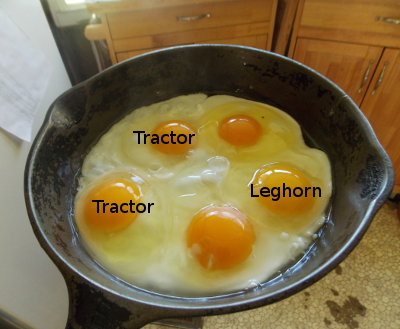
Who lays the best eggs?
 Since we've been averaging about half a cup of black-soldier-fly larvae going to the tractored
hens every day (plus they get all of our food scraps), I decided to run
a color test on yolks from our pasture versus from our tractor. I
hypothesized that the latter would have the most bright-orange yolks
due to all their treats...but I was wrong!
Since we've been averaging about half a cup of black-soldier-fly larvae going to the tractored
hens every day (plus they get all of our food scraps), I decided to run
a color test on yolks from our pasture versus from our tractor. I
hypothesized that the latter would have the most bright-orange yolks
due to all their treats...but I was wrong!
Instead, the orangest yolks came from the pastured hens (although the leghorn
egg was paler --- those flighty critters aren't as keen on scratching
for their dinner). It seems that even a daily offering of insects
and pepper tops isn't enough to make up for the hens' lack of space to
run around.
I should have thrown in a
store-bought egg to make this comparison really perfect, but I can tell
you from past experience that those yolks would be significantly paler
than even the Leghorn eggs. So, yes, you will be improving over
store-bought with a chicken tractor, but for absolutely tip-top eggs,
you need to use rotational pastures and to choose those varieties wisely. Enjoy your orange yolks!
Want more in-depth information? Browse through our books.
Or explore more posts by date or by subject.
About us: Anna Hess and Mark Hamilton spent over a decade living self-sufficiently in the mountains of Virginia before moving north to start over from scratch in the foothills of Ohio. They've experimented with permaculture, no-till gardening, trailersteading, home-based microbusinesses and much more, writing about their adventures in both blogs and books.
Want to be notified when new comments are posted on this page? Click on the RSS button after you add a comment to subscribe to the comment feed, or simply check the box beside "email replies to me" while writing your comment.

Years ago I spent some time in Italy. I always wondered why they referred to the yolk as the "red" of the egg instead of the yellow. It became clear when I started raising free-range hens.
I think the white hens (Leghorn, Poulon) lay paler eggs, making less pigment in general, than the others on the same diet.
Hi Mark and Anna,
I was reading the end of a blog on marksdailyapple about teeth.
The mom who wrote in said her milk got much more orange when she ate dark green stuff. She thought it was due to the large amount of chlorophyl?
Given that one test for beta-carotene and vitamin A is also colormetric, I wonder what is actually in the orange - red egg yolks? Some folks have written about Brix testing egg whites and seen variations from 12 to 16. Maybe if a few of us test our eggs and write in with our data a pattern will emerge?
Has anyone done any measurements or do they have other experiences maybe health related to share?
John